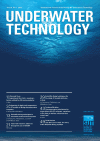
Simulation of oblique propeller flow including cavitation and pressure pulses
In this paper, the performance of an inclined propeller in both non-cavitating and cavitating conditions was investigated using a finite volume based solver. The results were compared with the experiments conducted at the Potsdam Model Basin (Germany) (Barkmann et al., 2011; Kinnas
et al., 2015). The propeller in the experiments was operating in an inhomogeneous flow and, therefore, the characteristics were deeply influenced by the inclination angle. Therefore, the present work includes both design and off-design conditions and simulations in a pull configuration. The
sliding mesh technique was used to implement the rotations in the unsteady Reynolds-averaged Navier–Stokes (URANS) solver, with the renormalisation group (RNG) Κ – ε turbulent model. The effects of models for acoustics and cavitation phenomena were of particular
interest and, therefore, multiphase mixture model was used as a cavitation model in which Rayleigh-Plesset equation describes the growth of a single vapour bubble in a liquid. Also, the Ffowcs–Williams and Hawkings (FWH) and direct methods were compared by predicting pressure pulses
at receiver locations. The analysis involved visual observation of the cavitation pattern, in that there was a good agreement between the numerical predictions and the experimental data. The pressure fluctuations at different locations were also compared with the experimental data for both
cavitating and non-cavitating cases. In the non-cavitating case, the amplitudes of the pressure fluctuations were in agreement with the experimental data, but those of pressure pulses in the cavitating condition were underpredicted. The spectral analysis of calculations also revealed the weak
third harmonic observed in the experiments. The FWH approach produced good results in the spectrum of rotating propeller and, therefore, instead of the direct method, the FWH approach is recommended in such complicated cases as pressure pulse and cavitation. However, a more advanced method
is required to extend the work for better representation of bubble dynamics.
Keywords: CAVITATION NOISE; MARINE ACOUSTICS; PRESSURE PULSE; PROPELLER; TEST-CASE
Document Type: Research Article
Publication date: 01 July 2016
- Underwater Technology is the peer-reviewed international journal of the Society for Underwater Technology. The objectives of the journal are to inform and acquaint the Society's members and other readers with current views and new developments in the broad areas of underwater technology, ocean science and offshore engineering.
- Editorial Board
- Information for Authors
- Submit a Paper
- Subscribe to this Title
- Membership Information
- Terms & Conditions
- Ingenta Connect is not responsible for the content or availability of external websites
- Access Key
- Free content
- Partial Free content
- New content
- Open access content
- Partial Open access content
- Subscribed content
- Partial Subscribed content
- Free trial content